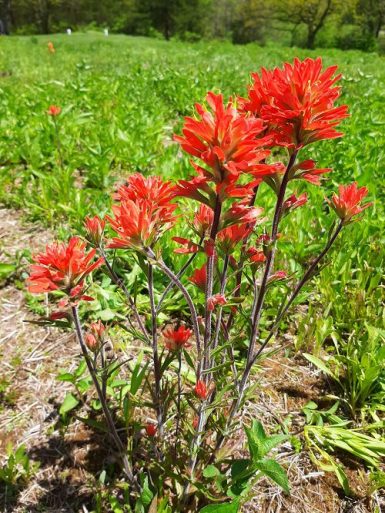

Plant chemistry is sufficiently complex that you would expect plant parasites to specialize and where it has been studied, some plants make much better hosts than others. Not surprisingly, they don't transplant well. (Some species do extremely poorly without being attached to a host and others have not been studied.) They can be cultivated but providing suitable hosts is important for success. Seeds will germinate, grow, and flower without a host, but they grow better and faster when they can attach to a host. That is, they can grow successfully without a host. The story is complicated by the fact that Indian paintbrushes are facultative, not obligate, hemiparasites. Hemiparasites like Indian paintbrushes do some photosynthesis and have green leaves, but also tap the roots of other plants and feed off their neighbors. Fully parasitic plants (holoparasites) have pale or orange leaves, not green, and get all their sustinence from other plants. They are difficult to grow because they are hemi-parasites. You can buy Indian paintbrush seeds, but you rarely find the plants in gardens. They produce their bright floral displays in high summer and later release tiny, dustlike seeds into the wind.

The Indian paintbrushes are small, herbaceous plants, generally perennial. The scientific name, Castilleja honors Domingo Castillejo (1744-1786), professor of botany at the Royal Naval College of Surgery, Cadiz, Spain, to whom many plant collections from the Americas were sent. Indian paintbrush from central Colorado mountains Every spring from that time, the hills and meadows burst into bloom with Little Gopher's paintbrushes. In the morning, the hill was ablaze in color, because the discarded brushes had taken root and turned into flowers, colored yellow and red and orange. In the twilight he returned to the village to show them his painting, a masterpiece of color. Hurriedly, skillfully, he painted the sunset, casting aside the brushes as he finished in his haste to capture the fleeting colors.

#INDIAN PAINTBRUSH FLOWER FACTS FULL#
Scattered in the grass were brushes full of bright paint. Then a dream vision, praising his art's contribution to his people, sent him up his favorite hill at sunset. In particular, he wanted to paint the brilliant colors of the sunset. He gathered rocks and plants to make his colors, but always wished for brighter ones. As he grew, he recorded the tribe's history in beautiful paintings. The book tells of a boy, Little Gopher, who was too small to do well at hunting or fighting, and was comforted by a dream vision that instructed him to pursue his talent for art. There is a Native American story, retold by Tomie dePaola as lovely picturebook, that recounts a legend of the origin of Indian paintbrush plants, a story told by a number of North American tribes. If you look carefully you can see the green flowers Presumably the name paintbrush refers both the variety of colors and the shape of the flower head. The bracts can be any shade from white through yellow and orange to red. The flowers are green, but surrounded by bright bracts (modified leaves) that make the plants so colorful and visible. The USDA gives the common name owl's clover to two species, calls one johnny nip and another cream sacs for another species of Castilleja, but all the rest are called some version of Indian paintbrush. North America has most of this genus, although a few species migrated to Eurasia and South America. See the diversity of the flowers in the Wikipedia article link). There are a lot species of Indian paintbrush-160 in North America!-all but a couple native to the western half of the continent (view USDA plants species maps and marvel link. Indian paintbrush, Castilleja, in western Wyoming Also called flame flower, prairie-fire, squaw feather, and painted cups, the Castilleja species, now classified in the owl clover family, Orobanchaceae, but long considered figworts, Scrophulariaceae, are handsome wildflowers. They're a splash of orange on the mountainside or of red in the meadow: Indian paintbrushes.


 0 kommentar(er)
0 kommentar(er)
